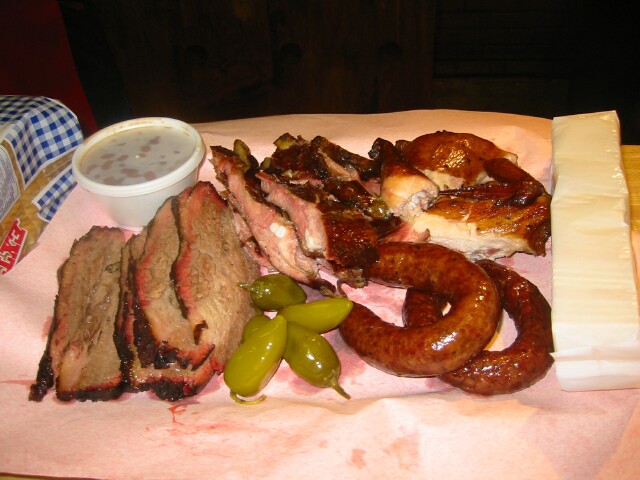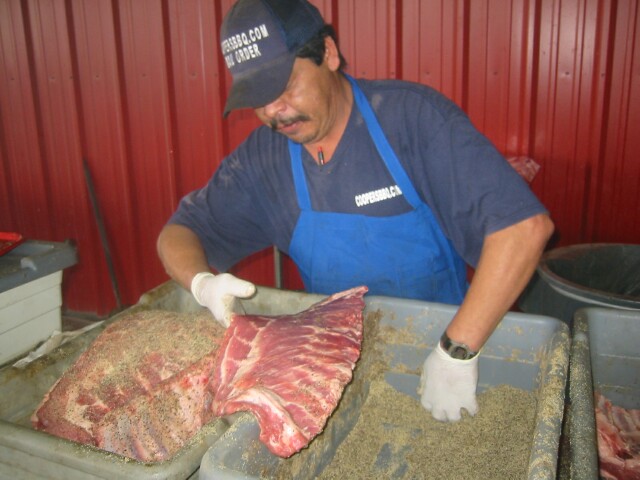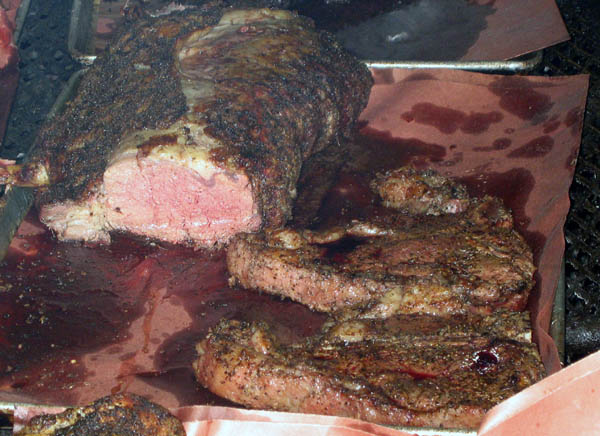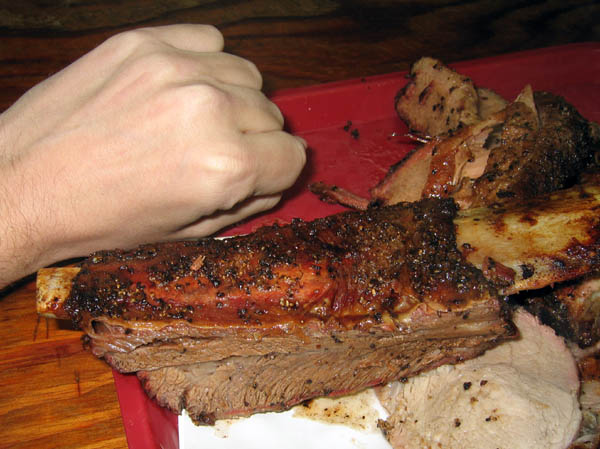Texas BBQ, Pork vs Brisket (The Good, The Bad and The Hecky)
Texas BBQ, Pork vs Brisket (The Good, The Bad and The Hecky)
-
-
-
-
-
Texas BBQ, Pork vs Brisket (The Good, The Bad and The Hecky)
-
Post #1 - December 15th, 2004, 6:56 amContinuation of The Good, The Bad and The Hecky thread on Eating Out in Chicagoland Board.
LTH,
I can only speak to the Houston and Hill Country area but, while Texas style beef brisket gets all the press, deservedly so I might add, pork, mainly in the form of spare ribs, is very much in evidence.
While Texas brisket is the stuff of dreams, especially Cooper's in Llano, I've had quite good spare ribs at any number of Texas BBQ joints. Otto's and Thelma's, both in Houston, spare ribs are excellent as are Black's in Lockhart and Salt Lick in Driftwood.
Thelma of Thelma's in Houston with spare ribs
Black's BBQ Lockhart, Texas
Cooper's in Llano's spare ribs getting application of 'secret' black and white rub.
While I'm sure somewhere, someplace, in Texas a BBQ joint serves only brisket, and brisket from the left side of the cow none the less, I basing the above on visiting 11-12 Texas BBQ joints in the last few years.
Cooper's (Llano)
Louie Mueller's (Taylor)
Black's (Lockhart)
Kreuz (Lockhart)
Southside Market (Elgin)
Meyer's (Elgin
Salt Lick (Driftwood)
Otto's (Houston)
William's Smokehouse (Houston)
Thelma's (Houston)
Goode and Company (Houston)
Enjoy,
Gary
-
-
Post #2 - December 15th, 2004, 7:08 amJust to clairfy, I never said that there was no pork in Texas. I just said that brisket is king. I've been to several of the places you mentioned and have tried the spares, but I stick to what I said. Wouldn't you agree with my original statement?
The hierarchy of Texas BBQ, IMHO, is brisket, sausage, turkey/chicken, ribs and never (or very rarely) pulled pork.Steve Z.
“Only the pure in heart can make a good soup.”
― Ludwig van Beethoven
-
-
Post #3 - December 15th, 2004, 8:42 amstevez wrote:Wouldn't you agree with my original statement?
Steve,
No, I would not, or should I say a qualified no, I would not.
I agree in Texas brisket is king, and in many parts of Texas sausage aka Hot Guts runs second, but, from my observation, spare ribs are an important part of Texas BBQ repertoire as well as beef rib, chicken, turkey, mutton, goat and pretty much anything that walks and/or flies.
"When visitors from Carolina and Tennessee come to Texas, they are generally astonished to find that we eat a lot of pork here as well as beef brisket. That's the problem with the beef generalization. Yes, we barbecue beef--but we're also fond of other meats"
Rob Walsh, Legends of Texas Barbecue Cookbook
In my opinion trying to pinpoint BBQ in Texas beyond brisket is as pointless as a NY vs Chicago pizza or hot dog debate.
Enjoy,
Gary
-
-
Post #4 - December 15th, 2004, 8:43 amI tend to agree with the sentiment that Texas BBQ is more about the process than any particular meat. After all, the best thing I had in my brief recent Q foray was mutton. Down in Lockhart, the feuding family Kreutz/Smitty's are both known for their meats not rib or brisket. For instance, they smoke beef shoulders known as clod, prime ribs and whole pork loins. Great pictures of Lockhart meats can be seen here. Remember that these places pretty much all got started as butchers/markets not restaurants and smoking meat was a way of dealing with what was left from the cow or pig (as was making sausage).
Now, saying all of that, I am incredibly sad to report that in my few trips to central Texas, I have not had clod or smoked prime rib or smoked pork loin. But there is always next time...
Rob
-
-
Post #5 - December 15th, 2004, 10:17 amOK then. I'll revise my hierarchy of Texas BBQ as follows:
1. Brisket
2. Sausage
3. Turkey/Chicken
4. Ribs (pork or beef)
5. Specialty meats (site specific)
6. Never pulled pork (unless the place is billing itself as a NC pulled pork restaurant)
Rob, you were lucky to run into a place serving mutton, but I don't think serving mutton is all that wide spread. The same can be said of clod, prime rib and pork loins. Those items are site specific specialties rather than generally available BBQ items. I have included them in my list, though. Also, items 3 and 4 are probably interchangable depending on where in Texas you are.
The list is meant to be a ranking of how common the listed items are in Texas, not any definive list of all of the BBQ items items served there.Steve Z.
“Only the pure in heart can make a good soup.”
― Ludwig van Beethoven
-
-
Post #6 - December 15th, 2004, 11:03 amSteve,
I think I've been working too hard of late, and thus, this morning, I am ODing on minor LTH points. I do not have a stake in this battle per se, nor do I know why I feel compelled to reply, but...
One can get pork as in pork shoulder or pork butt all over Texas. In Austin, the twin East side Q halls, Sam's and Ben's both sell pork butt. In Dallas, Sonny Bryant's sells pork. And there is the Pig Shack chain all over Texas.
As Texas is a VERY big state, there are multiple BBQ traditions merging and interacting within the state. I mean there is also some very cool cabrito restaurants in Houston, San Antonio etc. which is really BBQ too. There are some great pictures of the roasting goat in the latest issue of Texas Monthly. But anyways, I think at a minimum, there is an urban and a rural division within Texas Q. It is just hard to make broad statements.
Rob
-
-
Post #7 - December 15th, 2004, 11:30 amI just wish that I could pick up beef brisket in Chicago at El Paso (0.89/lb) prices.
-
-
Post #8 - December 15th, 2004, 2:13 pmThis year my brother moved to North Carolina. This summer I visited him and we went exploring.
We heard a lot about North Carolina BBQ so we went to Lexington, the epicenter for at least one particular style. There, pork shoulders are slow-cooked over hickory, the meat is pulled off the bones and chopped fine. No sauce is used except at table and it is a thin, vinegar-based liquid. A black-pepper-heavy cole slaw is the typical side dish. When served as a sandwich, the slaw is placed on top of the meat in more-or-less equal proportions.
We went to a place--the name escapes me now--that the guidebooks recommended. We went on a Saturday afternoon. It certainly had the right atmosphere and both the restaurant and pick-up window were doing brisk business. I was underwhelmed. It seemed like a lot of work to create a lightly smokey but otherwise bland, dry meat mush. The slaw was more interesting.
I, too, miss NN. To me, that was BBQ. (Great noodles too.)
-
-
Post #9 - December 15th, 2004, 2:40 pmOne man's meat mush is another's pork cotton candy. But that does not sound like a good experience. At best, NC BBQ has a well-integrated mix of the relatively bland, soft white muscle, flavorful fat, and super-flavorful and smoky skin, all hacked together and doused with the vinegar-based sauce. Doesn't sound like what you got.
-
-
Post #10 - December 15th, 2004, 8:10 pmThe bland, soft, white muscle sounds familiar but they must have been saving the rest of it for the locals. Next time I'm there, though, I'd be willing to try again.
-
-
Post #11 - December 16th, 2004, 1:23 pmMy experience in that region is that the whole is much greater than the sum of its parts, especially when it comes to pulled or chopped pork. In this case, the "whole" is a sandwich in which morsels of pork (Mr. Brown and Ms. White) are tossed in a very vinegary/peppery sauce, on squishy white bread with a dollop of crispy cole slaw. When all of these come togther, the combination of smells, flavors, and textures is extradorinary. Much like my first experience with a really good Cuban pork sandwich. The individual ingredients seem like nothing special, but when combined correctly, WOW!
Bill/SFNM
-
-
Post #12 - December 29th, 2004, 6:20 pmAh, Texas barbecue. That's a topic of some interest to me. I know I'm coming to this conversation late; but here are some quick thoughts on what's been said.
I'm going to have to agree with some of those who have questioned SteveZ's characterization of Texans' brisket fixation. While many Texans love brisket, the stereotype that they love only or primarily brisket is false. Robb Walsh attacks the stereotype in his excellent "Legends of Texas Barbecue," laying out some of the historical and demographic forces that led to the incredibly diverse barbecue scene in Texas. In a nutshell, you have black populations (largely in East Texas), German and Czech immigrants (particularly in Central Texas, along the cattle trails), and Mexicans (West and South).
A lot of what SteveZ says about Texas barbecue (generally) is more true of Central Texas barbecue, where (a) barbecue grew out of the meat markets along the cattle trails, meaning beef was king, and (b) the Germans and Czechs brought their sausage-making skills to the table. But, even within that region, there's a wide diversity of meats--brisket (fatty and lean, which is a distinction that should be more widely made), spare ribs, beef ribs, lamb and mutton ribs, shoulder clod, pork loin, beef sausage, pork sausage, venison sausage, hot links (including the famous versions from the "sausage capital of Texas," Elgin), chicken, turkey, ham, et al.
Go a little farther west and things change. Instead of indirect heat from post oak, you get more direct heat and mesquite smoke. Though brisket is present, it's not as critical as it is in the region described above. Cabrito becomes more common (and quail and dove can sometimes be found). (Barbacoa, which some also consider a form of barbecue, continues to spread from the Valley, including pork, cow, and Guanajuato-style goat head.)
Go east from the German/Czech Belt and the black influence pushes pork to the top of the list. Hickory and pecan are the more common woods. And meats are often finished wrapped tightly in tin foil to steam them to tenderness. While a sloppily sauced spare rib with meat falling off the bone would be inexcusable in Central Texas (where the ideal is a dry rub, if any, no sauce, and meat that's tender, but firm enough to just cling to the bone), it's the preferred form in the piney woods of East Texas. Rib sandwiches and hot links are the way to go out there (and pulled pork isn't unheard of).
Go further north and hickory becomes the wood of choice. Meat selections include almost all of the above (with the exception of cabrito, which is only available in a few Mexican joints, and is usually more "al pastor" than barbecued), but will also include the occasional bologna or salami. If there is a clear meat preference in North Texas, it would not be for brisket, since most places up there do it poorly.
All of these are still stereotypes--just less inaccurate ones. Exceptions abound all over the state. And we're not even talking about some of most commonly ordered items in bbq joints: sandwiches, a category in which there's also considerable variety. Or barbecued baked potatoes. Or barbecued Frito pies.
There are thousands of barbecue joints in the state of Texas, spread over areas that differ geographically (resulting in differing economic forces affecting choices of meat, wood, and cooking method) and demographically (meaning wide differences in tastes, traditions, and expertise). And I doubt that most Texans--even those who fancy themselves barbecue connoisseurs--have eaten at more than a dozen in their respective home towns. But even if they'd been to two hundred across the state, that's a drop in the bucket. Making generalizations about a market that big is a dicey proposition.
Scott
PS Rob, I just wanted to apologize for the shabby treatment you got from a couple of Chowhounds (one of whom is consistent problem for the moderators, so don't feel singled out) before your recent trip to Austin. Texas hospitality is generally much better than that.
-
-
Post #13 - December 31st, 2004, 12:13 amIt's an absolute shame that Scott wouldn't involve himself in some shameful self-promotion, so I'll add the link to his site that he should have:
http://www.dallasfood.org
If you like Texas BBQ and haven't looked at his site, you're missing out.
PS: Nice pics, Gary.
PPS: If you haven't checked out Robb Walsh's book on Texas BBQ, you really should. Great book. Great writer.
-
-
Post #14 - December 31st, 2004, 6:02 amBill/SFNM wrote:My experience in that region is that the whole is much greater than the sum of its parts, especially when it comes to pulled or chopped pork ... The individual ingredients seem like nothing special, but when combined correctly, WOW!
Bill:
I agree completely and would (as I in fact recently did in a thread on NC here) go a step further and add that the overall experience is further improved by the presence of good slaw and good hush puppies. I have long been a big fan of NC eastern style cue but, after having had it quite a few times, I now finally understand the 'chemistry' of it all better than I did.
On the other hand, I can understand cowdery's not so great experience with the stuff, perhaps attributable narrowly to what he got served that day but also, let's face it, some folks just don't think much of the stuff too. But I do hope cowdery gives it another shot, maybe adding the pups into the deal, at another good place.
AntoniusAlle Nerven exzitiert von dem gewürzten Wein -- Anwandlung von Todesahndungen -- Doppeltgänger --
- aus dem Tagebuch E.T.A. Hoffmanns, 6. Januar 1804.
________
Na sir is na seachain an cath.
-
-
Post #15 - December 31st, 2004, 10:07 amcowdery wrote:We heard a lot about North Carolina BBQ so we went to Lexington, the epicenter for at least one particular style.
Hey y'all:
If Chuck went to Lexington for 'cue he was eating so-called "western-style". What Antonius is talking about -- and I would guess Jeff and Bill as well -- is the eastern-style. Maybe it's just that Chuck doesn't care for the western style. If so, everyone in NC from Chapel Hill east would agree with him.
Chuck, where does your brother live? Maybe you can get some ideas for further barbecue tasting on your next trip by looking at the suggestions given nr706 in the NC thread.
Amata
-
-
Post #16 - December 31st, 2004, 4:38 pmMy brother lives in Raleigh and had just moved there at the time, so he didn't know anything or anyone. I'm sure by my next visit he'll know his way around better.
Most of my BBQ experience is from Kentucky and Tennessee. My brother lived for a long time in Dallas, so that's his main influence.
And I absolutely did have the hush puppies in Lexington. They were great!
-
-
Post #17 - January 13th, 2005, 1:45 pmGWiv
I saw your list of Texas BBQ joints that you went to. All of them, except for the Houston joints, are on my list for my upcoming trip. Are there any that I should skip in order to make room for other more deserving places?
-
-
Post #18 - January 13th, 2005, 2:31 pmTrixie-pea,
I'm not G Wiv. But, as one somewhat familiar with Texas barbecue, I would say that the only non-Houston place on his list that Central Texans might steer you away from would be the Salt Lick, in Driftwood, Texas. Opinions are very divided on it; but the consensus of knowledgeable barbecue-lovers in the area seems to be that they've passed their prime and are not on par with the truly legendary joints in the region (many of which are included in G Wiv's list).
The overall quality of his list is good. While he's mentioned a lot of the top names, there are others worth trying while you're in the area. For instance, if you're in Elgin for Southside and Meyer's, there's no reason not to also go to Cross-town. If you're in Lockhart for Black's and Kreuz Market, to skip Smitty's (which is the original location of Kreuz Market before it relocated out to the highway) would be a critical omission. If you're going to Llano for Cooper's, you might also want to check out Laird's (opened nearly a quarter century ago by a former pit boss from Cooper's) and Inman's Kitchen. (And, on the way to Llano, you could hit Opie's in Spicewood and Inman's Ranch House in Marble Falls.) If you're in Taylor for Mueller's, you should also hit Vencil's Taylor Cafe and, if you're up for it, Mikeska's--all three are within a block of each other. City Market in Luling is exactly 15 minutes south of Lockhart and should not be missed. But then Gonzales Food Market is just a little farther down the highway from Luling. And then you can head southeast to Navasota for Ruthie's. Or New Zion Missionary Baptist Church in Huntsville. Once you hit the road in Texas, there's always more great barbecue just a few miles further.
Scott
-
-
Post #19 - January 13th, 2005, 3:30 pmThanks Scott for your suggestions--I will try to hit all of them.
Any feedback on Fushak's in San Marcos or R.O.'s in Spicewood?
-
-
Post #20 - January 13th, 2005, 4:23 pmTrixie-pea,
It's been nearly a decade since my last visit to Fuschak's. Unless they've improved considerably, they're not anywhere close to the same league as the other names you're looking at.
My lone experience at R.O.'s Outpost was rather poor, as you can read about in the report at the following link:
http://www.dallasfood.org/modules.php?name=News&file=article&sid=9
How long will you be in Central Texas? With as many joints as you have on your list, you might literally be biting off more than you can chew. You'd be well advised to take special note of any strengths and weaknesses of each place you plan to visit, so you can get the most out of it. Trying everything at every place would be nearly impossible. When you look into the holding pit at Cooper's (in Llano), you'll see sausage, brisket, spare ribs, beef ribs, pork loin, prime rib, double-cut pork chops, sirloin, cabrito (ribs, shoulder, foreshank, etc.), chicken, and sometimes turkey and/or ham.
You'll encounter similar ordering dilemmas at many of the places on your list. Sometimes, knowing what to order will be easy (e.g., sausage in Elgin). But at the top tier places, most things are so good that I'm left wringing my hands every time I'm there. There are definitely worse situations to be in. (New York comes to mind.)
Scott
-
-
Post #21 - January 13th, 2005, 9:08 pmYou know what they say about the best laid plans...but, since it's my first time in Austin, I'm treating this trip as a scouting trip. My goal is to try as many reputable places as I can--so that I can get an overall feel for the area. I will be there for five solid eating days--so I don't think an average of 3-4 joints a day is an unreasonable endeavor. We'll see though--one can only eat so many sausages. Oh, which reminds me---when ordering BBQ by the pound, something I'm not accustomed to doing, are they any good rules of thumb about portion size?
Scott--the link you gave is an excellent resource--thanks for that.
-
-
Post #22 - January 14th, 2005, 10:41 amPortion size is a classic dilemma. Do you try a spoonful of each of the 31 flavors? Or do you get full scoops of three of them? For your purposes, you're probably going to want to try as many things as possible. But when you find something really good, it'll be hard to put it back down on the butcher paper. Good luck with it!
Scott
-
-
Post #23 - January 20th, 2005, 8:42 amScott--DFW wrote:Once you hit the road in Texas, there's always more great barbecue just a few miles further.
Scott,
Your suggestions to Trixie-pea contain one or two I'd not heard of and will be a great starting point for my next Hill Country BBQ tour, thanks.
One of the places you mention, New Zion Missionary Baptist Church in Huntsville, is high on my list of place to try. New Zion is only open on weekends and runs out of BBQ early, correct? Any thoughts on the place overall?
I was just poking around your web site and really enjoyed the BBQ pictures, put me in the mood for brisket and 'Hot Guts'. Though since I can't get to Cooper's in Llano or Meyer's in Elgin in the next day or 40, it's brisket and sausage on the smoker this weekend.
Regarding Salt Lick, it's been a few years but I remember the spare ribs being quite good and the coleslaw excellent. My wife still considers Salt Lick's coleslaw the best she has tried, not just BBQ places. Salt Lick's coleslaw had the merest hint of Asian flavor, I believe the wife of the original owner is Japanese. I've tried, with little success, to duplicate Salt Lick's slaw, any suggestions?
As far as the list of Texas BBQ places I posted, that was not meant to be a comprehensive best of the best, simply a list of the Texas places I've been in the last few years. Best of the best would be Cooper's in Llano, where god goes when she's in the mood for brisket.
Enjoy,
Gary
-
-
Post #24 - January 20th, 2005, 10:05 amDoes anyone read the Rosengarten Report? A while back, he did an article on Texas mail order BBQ. He covered the BBQ that he thought worked via mail order, and how to properly bring it back to life. When I read it the first time I thought that it was crazy to mail order something like BBQ. Not only because of fears that the quality would suffer, but because half the fun of BBQ is having the smoke smell seep into your hair and clothes--either from the joint, or your own smoker.
BUT--during my trip, I may have to inquire about it. And if it seems worth it, then what a fun party-experiment that would be for the LTH'ers to take on.
-
-
Post #25 - January 20th, 2005, 12:24 pmG Wiv, I like Salt Lick, too. But from what I understand it's pretty inconsistent. I'm also first and foremost a rib person. SL is the first place where the sauce has really mattered to me. I spent days trying to recreate it. I had a jar in my frig and I would try and try. Made a decent sauce ultimately, but it just wasn't the same. It also has an Asian influence. I think some of the animosity towards Salt Lick (not from Scott, but others) is that it's "too commercial".
-
-
Post #26 - January 20th, 2005, 4:55 pmG Wiv wrote:New Zion is only open on weekends and runs out of BBQ early, correct? Any thoughts on the place overall?
As I recall, it's open Wednesday through Saturday. And, yes, they close when they run out. Not the best barbecue in Texas. But pretty good East Texas style ribs and very unique atmosphere. Well worth doing, for anyone passing through Huntsville.Regarding Salt Lick, it's been a few years but I remember the spare ribs being quite good and the coleslaw excellent.
On some occasions, the ribs I've had there have been among the best I've ever had. On others, they were just okay. They're less consistent than many of the Central Texas heavyweights. (I've never had great brisket there. And their sausage is rather ordinary.) But, as ExtraMSG says, their sauce is interesting and, I think, delicious. (Robb Walsh has a recipe that strives to recreate it in his "Legends of Texas Barbecue" book. Have you tried that one, Nick?) I have no ideas on their cole slaw, Gary. I rarely eat sides, when the meat is good.Best of the best would be Cooper's in Llano, where god goes when she's in the mood for brisket.
Ah, Cooper's. Not everyone likes that mesquite flavor. But, having grown up in mesquite-grilling north Texas, I find it irresistable. Next Monday, I'll be posting a report on a recent visit to Llano on the DallasFood.org web page. Good stuff. (Cooper's prime rib and sirloin are pictured above.)
Scott
-
-
Post #27 - January 20th, 2005, 5:21 pmNo, I have the book, Scott, but I haven't tried it. I'll have to make both my recipe and theirs and compare to my memory.
-
-
Post #28 - January 24th, 2005, 11:35 amG Wiv wrote:Best of the best would be Cooper's in Llano, where god goes when she's in the mood for brisket.
The report on barbecue in Llano (including Cooper's) is now up at the following link: http://www.dallasfood.org/modules.php?name=News&file=article&sid=17
Scott
-
-
Post #29 - January 24th, 2005, 12:02 pmDamn, Cooper's looks good.
Interesting that the Cooper's style of cooking pork ribs is nearly identical to what is done in Chicago's better pits.
Thanks.
-
-
Post #30 - January 24th, 2005, 12:23 pmThanks for the link. Wow, does that stuff look good!

